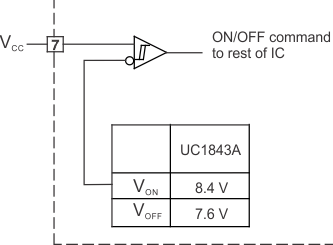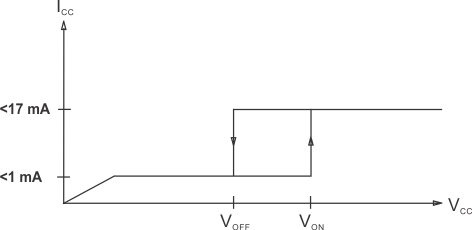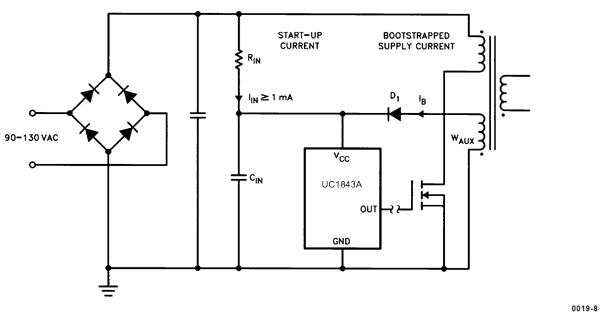SLUS872E January 2009 – February 2019 UC1842A-SP , UC1844A-SP
PRODUCTION DATA.
- 1 Features
- 2 Applications
- 3 Description
- 4 Revision History
- 5 Device Comparison Table
- 6 Pin Configuration and Functions
- 7 Specifications
- 8 Detailed Description
- 9 Application and Implementation
- 10Power Supply Recommendations
- 11Layout
- 12Device and Documentation Support
- 13Mechanical, Packaging, and Orderable Information
Package Options
Mechanical Data (Package|Pins)
- JG|8
Thermal pad, mechanical data (Package|Pins)
Orderable Information
8.3.1 UVLO
The UVLO circuit ensures that VCC is adequate to make the UC184xA-SP fully operational before enabling the output stage. Figure 5 shows that the UVLO turnon and turnoff thresholds are fixed internally at 16 V and 10 V, respectively. The 6-V hysteresis prevents VCC oscillations during power sequencing.
Figure 6 shows supply current requirements. Start-up current is < 1 mA for efficient bootstrapping from the rectified input of an off-line converter, as shown in Figure 7. During normal circuit operation, VCC is developed from auxiliary winding, WAux, with D1 and CIN. However, at start-up, CIN must be charged to 16 V through RIN. With a start-up current of 1 mA, RIN can be as large as 100 kΩ and still charge CIN when VAc = 90-V RMS (low line). Power dissipation in RIN would then be less than 350 mW even under high line (VAc = 130-V RMS) conditions.
During UVLO, the output driver is in a low state. While it does not exhibit the same saturation characteristics as normal operation, it can easily sink 1 mA, enough to ensure the MOSFET is held off.
 Figure 5. UVLO Turnon TurnOff Threshold
Figure 5. UVLO Turnon TurnOff Threshold 
 Figure 7. Providing Power to the UC184xA-SP
Figure 7. Providing Power to the UC184xA-SP